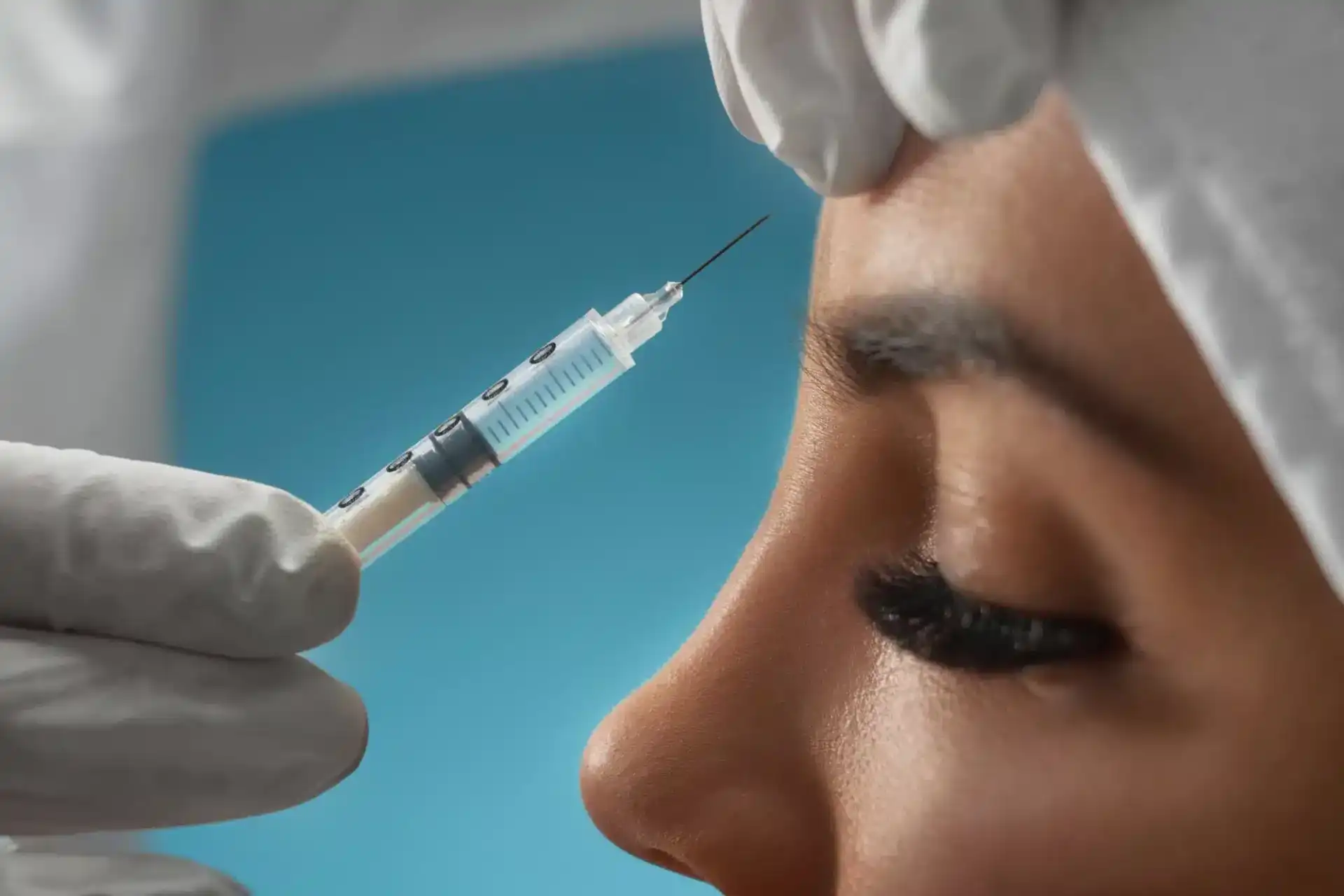
Using Botox for Bunny Lines
David Fuller
Last Updated On: October 15, 2024
What are bunny lines? When we don’t like something or mentally say no, “bunny wrinkles” start forming on the bridge of the nose. Nasalis fanning rhytides, also known as bunny lines, are the wrinkles on either side of the nose that appear when a person scrunches their nose.
The skin covers the muscles like tissue, and when we show emotions, this tissue becomes crumpled, causing wrinkles, folds, and small creases to form on the skin. A person would have to exercise complete control over their facial expressions to keep bunny lines at bay. Being unable to show emotion would be a challenge for anyone, so this doesn’t really help.
There is a solution, though – relaxing the muscles of the face that form folds and creases, and that is something neurotoxin injections can help with.
Bunny Lines Botox Treatment
Botulinum toxin is a protein that disrupts the transmission of a nerve impulse from a nerve ending to a muscle. Penetrating through the membrane of the nerve ending, it eliminates a particular group of proteins. The group targeted depends on the type of drug used.
For example, type A toxin (Botox) counteracts the protein SNAP-25; it eliminates the possibility of an association between acetylcholine bubbles (the “messenger” that causes muscle contractions) and the cell membrane. Therefore, although the muscles receive a nerve impulse, their full contraction does not occur. Instead, the muscle at the injection site relaxes, the skin is smoothed, and the wrinkles disappear.
Point injections of botulinum toxin drugs relax hyperactive facial muscles. Patients no longer frown or wrinkle their forehead, nose, and lips; their face looks calm and confident, without wrinkles and folds.
During the drug’s effective lifetime (up to six months), patients get used to not wrinkling and frowning – thus preventing new wrinkles from forming. To maintain the effect, two to three sessions of botulinum therapy per year are enough.
Advantages of the procedure:
- Instant results;
- Longevity of the effect;
- Safety of the products used;
- Fast procedure;
- Lack of long-term rehabilitation;
- Competitive price;
- Prevents new wrinkles from appearing;
- Does not leave bruises or cuts;
- Restoration of sensitivity and mobility after Botox removal;
- Can be combined with other rejuvenating and restorative procedures.
Bunny lines Botox therapy is suitable for both younger and older patients, as mimic wrinkles can appear at any age. The sooner a person starts botulinum therapy, the better they will look at a mature age. It works equally well for women and men.
The drug is administered using thin needles, therefore, little preparation is required. However, a few nuances do exist:
- Antibiotics reduce the effectiveness, so the patient should avoid them before the procedure.
- Anticoagulants, including aspirin, should also be excluded for one to two days before the injection. These medications increase blood thinning and could lead to bruising in the injection area.
- A day before a cosmetologist’s appointment, the patient should avoid heavy physical activity, beaches, baths, and saunas.
Administration Of Neurotoxin And Injection Points
The procedure itself takes around 20–30 minutes. The technique for administering Botox to treat bunny lines involves the following steps:
- First, the injection area is cleaned and disinfected to ensure sterility. Then, an anesthetic cream may be applied if needed.
- The target muscles are identified by marking the overlying skin with a marker. The bunny lines Botox injection points are typically on either side of the bridge of the nose, usually at the highest point of the nose and at the areas where the bunny wrinkles are most prominent.
- The injections are superficial and placed into the skin, overlying the Nasalis muscle, allowing the Botox to diffuse into the muscle. To protect the Levator Labii Superioris Alaeque Nasi muscle, it’s crucial to avoid injecting too laterally or inferiorly. The injections usually take about 30 seconds to complete.
- After the bunny line Botox injections, light pressure is applied to the area to prevent bruising, and the skin marker is removed.
Patients should follow aftercare instructions provided by their doctor.
The procedure is painless – the patient can go to work or home immediately after it.
Risks and Side Effects
This type of treatment for bunny lines is safe, but like any medical procedure involving injections, certain Botox bunny lines complications can occur. Below are some risks associated with botulinum toxin procedures for bunny lines:
- Bruising and Swelling: After the procedure, it is common to experience some bruising and swelling around the injection site.
- Asymmetry: If botulinum toxin is not injected evenly on both sides of the nose, it may lead to asymmetry of the bunny lines.
- New wrinkles developing: Facial muscles near the injection site can become excessively mobile, provoking the appearance of new facial wrinkles;
- Over-treatment: If too much Botox is used, it may cause the bunny lines to disappear completely, leading to an unnatural appearance.
- Headache: Some people may experience mild headaches after the procedure.
- Allergic Reaction: In rare cases, some individuals may develop an allergic reaction to the injection.
There are also cases when a cosmetologist should refuse to perform botulinum toxin injections. The main contraindications include:
- Pregnancy and breastfeeding;
- Inflammation in the procedure’s area;
- Any active inflammatory processes in the body or elevated body temperature;
- Oncology;
- Blood coagulation disorders;
- Allergy.
Botox Bunny Lines Aftercare
Patients may notice numbness or stinging in the treatment area when they leave their Botox appointment. However, these side effects should wear off within a day or so.
Botox takes a while to show its effects fully. The patients should start seeing the results within three to four days, but it may take up to two weeks to get the full result.
Bunny lines Botox aftercare is relatively simple; outlined below are some basic patient guidelines:
- Avoid touching or rubbing the injection area for at least four hours.
- Avoid exercising, strenuous physical activity, and alcohol for the first 24 hours.
- Do not lie down for at least four hours after the procedure.
- Refrain from consuming alcohol for 24 hours after the Botox injections.
- Avoid applying makeup or skincare products to the treated area for at least four hours.
- Apply an ice pack or cold compress to the bunny lines Botox treated area to help reduce swelling or bruising.
- Do not massage the treated area for at least 24 hours.
These above guidelines cover the average situation; it is optimal to provide more specific instructions tailored to your patient’s needs and health situation. For the best results, and to minimize potential side effects, it is imperative to advise based on the client’s current circumstances.
FAQ
Can you do Botox injections for bunny lines?
Yes, Botox can be used to treat bunny lines. Neurotoxins can help reduce their appearance by relaxing the muscles that cause these wrinkles.
The procedure involves injecting small amounts of Botox or another botulinum toxin into the muscles around the bunny lines, reducing muscle activity, and softening the wrinkles.
Where do they inject Botox for bunny lines?
Botulinum toxin is typically administered into the upper part of the nose where the bunny lines appear. The injections are usually given in small doses on each side of the nose, targeting the muscles that cause the wrinkles when they contract.
The exact injection sites may vary depending on the individual’s facial anatomy and the severity of the bunny lines.
Can Botox in bunny lines affect a smile?
The Botox for bunny lines injections should not affect a person’s smile. However, when Botox is injected incorrectly or excessively, it can adversely affect the facial muscles, including those responsible for creating a smile.
It happens because the same muscles that cause bunny lines are also involved in certain upper lip movements, which can be affected by improperly administered injections.
However, this is rare; when a skilled and experienced professional performs the procedure, they can avoid the muscles responsible for smiling. Therefore, it is crucial to have Botox injections administered by licensed and experienced medical professionals to prevent potential adverse effects.
References
Kane MA, Monheit G. The Practical Use of AbobotulinumtoxinA in Aesthetics. Aesthet Surg J. 2017 May 1;37(suppl_1):S12-S19. doi: 10.1093/asj/sjw285. PMID: 28388719; PMCID: PMC5434487.
Ruiz-Rodriguez R, Martin-Gorgojo A. Ten Mistakes To Avoid When Injecting Botulinum Toxin. Actas Dermosifiliogr. 2015 Jul-Aug;106(6):458-64. English, Spanish. doi: 10.1016/j.ad.2015.04.003. Epub 2015 May 5. PMID: 25956528.
Flynn TC. Advances in the use of botulinum neurotoxins in facial esthetics. J Cosmet Dermatol. 2012 Mar;11(1):42-50. doi: 10.1111/j.1473-2165.2011.00593.x. PMID: 22360334.
Shetty MK; IADGart, Michael & Gutowski, Karol. (2015). Aesthetic Uses of Neuromodulators. Plastic and Reconstructive Surgery. 136. 62S-71S. 10.1097/PRS.0000000000001773.VL Dermatosurgery Task Force. Guidelines on the use of botulinum toxin type A. Indian J Dermatol Venereol Leprol. 2008 Jan;74 Suppl:S13-22. PMID: 18688099.
Kashkouli MB, Amani A, Jamshidian-Tehrani M, Yousefi S, Jazayeri AA. Eighteen-point abobotulinum toxin a upper face rejuvenation: an eye plastic perspective on 845 subjects. Ophthalmic Plast Reconstr Surg. 2014 May-Jun;30(3):219-24. doi: 10.1097/IOP.0000000000000053. PMID: 24481513.
Yi, K.-H.; Lee, J.-H.; Hu, H.-W.; Kim, H.-J. Novel Anatomical Guidelines on Botulinum Neurotoxin Injection for Wrinkles in the Nose Region. Toxins 2022, 14, 342. https://doi.org/10.3390/toxins14050342
Products
Cart
Log In
Newsletter
Subscribe for exclusive offers and updates on new arrivals
Share feedback at:
Working Hours
MON - SUN 9AM to 6PM EST
The Most Popular Brands
Med Supply Solutions
Support
Secure checkout is guaranteed with full adherence to PCI DSS payment standards.
Products listed here are guaranteed authentic and manufacturer-sourced.
Pay easily with trusted providers


Copyright 2025. Med Supply Solutions